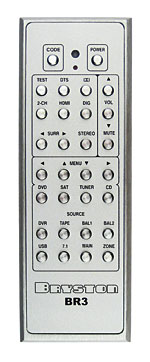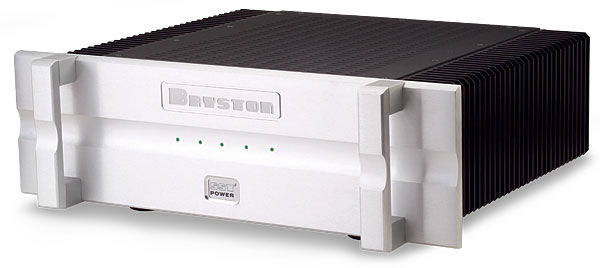Bryston SP3 Surround Processor and 9B SST² Amplifier Page 2
 It’s Never a Dull Moment while listening to Rod Stewart’s “You Wear It Well” on some classic and rare DCC 180-gram vinyl. Channel separation was excellent, and the electric and acoustic guitars held their definition superbly. A friend of mine is a mastering engineer, and he told me he’d recently been listening to a lot of older music (like this) and just marveling at how honest and defined it was. Or maybe that’s just me interpreting what he said into audio reviewer terms. So much of what is produced today lacks natural dynamics. It’s just a wall of sound with little definition. One big, phat note, clubbing you into submission. How great to hear the horns on “I’d Rather Go Blind” blended into the mix with the guitars, neither of them losing their space or definition. The SP3 and 9B SST² are capable of such natural, detailed, and honest resolution, it made me jump up and dance when “Twistin’ the Night Away” came on.
It’s Never a Dull Moment while listening to Rod Stewart’s “You Wear It Well” on some classic and rare DCC 180-gram vinyl. Channel separation was excellent, and the electric and acoustic guitars held their definition superbly. A friend of mine is a mastering engineer, and he told me he’d recently been listening to a lot of older music (like this) and just marveling at how honest and defined it was. Or maybe that’s just me interpreting what he said into audio reviewer terms. So much of what is produced today lacks natural dynamics. It’s just a wall of sound with little definition. One big, phat note, clubbing you into submission. How great to hear the horns on “I’d Rather Go Blind” blended into the mix with the guitars, neither of them losing their space or definition. The SP3 and 9B SST² are capable of such natural, detailed, and honest resolution, it made me jump up and dance when “Twistin’ the Night Away” came on.
Dripping with old-time charm, Ray Charles’ “Crying Time” from a 1998 Rhino greatest-hits LP reminded me of what a hi-fi from the early ’60s might have sounded like cranking out Ray. The sound was deep and warm, with resolution and depth commensurate with a top-notch tube system of that day. It’s probably passé to mourn analog these days, but the Bryston has a purity of sound that brings back those memories. Get up and peer into the SP3 and 9B SST², and you won’t see the orange glow of tubes. But sit back, shut your eyes, and you’ll swear you’re in your basement rec room with your bare toes swimming in a multicolored shag and your mother yelling down from the top of the stairs something about smelling smoke.
Expanding two-channel music with various Dolby Pro Logic and DTS Neo:6 modes is possible and even enjoyable for a purist like me. I found that the Neo:6 Cinema mode worked best on a live recording of Eva Cassidy’s Live at Blues Alley CD, while Pro Logic II Natural did wonders for the Moody Blues’ To Our Children’s Children’s Children. In the latter recording, Pro Logic complemented the excessive reverb in the recording by building a tangibly believable acoustic environment. In straight stereo, it sounded dated and overdone.
Jack White’s latest solo CD, Blunderbuss, was recorded on analog tape, and while I’ve lost some of that groove by picking it up on CD instead of vinyl, it still exhibits dynamics more reminiscent of a late-’70s recording. The Bryston components presented a solid and stable center image while a reverberant piano and a drier acoustic guitar spread naturally across the soundstage on “Hypocritical Kiss.” The hum of the too-hot guitar amp at the startup of “I’m Shakin’” is easily, and unfortunately, exposed throughout the rest of the songs. The title cut has a live underground club feel with soothing instrumentation and breathy vocals. The Bryston SP3 and 9B SST² are resolution champs, shaking out the good with the bad, as it should be.
All You Zombies
I’ve had Zombieland in my stack of Blu-rays to watch for some time. The DTS-HD Master Audio soundtrack is pristine, with a lot of music in the soundtrack. The SP3 did a great job with this movie, offering excellent dialogue intelligibility even with the music pumped up. Turning to a movie with very little in the way of contemporary music, the gunshots in Safe House sounded extremely realistic, even from upstairs, rooms away, at least according to my son who was trying to study.
Besides movies, of course, I spent a lot of time watching HD material courtesy of DirecTV, and frankly, even the news sounded good. But shows like Sons of Anarchy and Homeland gained the good theatrical edge one would expect from a premium sound system. The classic rule of thumb in reviewing—if it sounds great on music, then it’s going to sound good on movies and TV—certainly held true.

Yup, the Bryston duo is expensive. The SP3 has no Internet radio streaming, but there is a USB input that accepts digital audio. No tuner, no room EQ, no video scaling or conversion, no component video routing. Umm...$9,500. So it better sound great, right? Well, it does, I have to admit. The 9B SST² amp is even easier to recommend, as it is super professional in build, performance, and finish. The combo will absolutely astound and connect you with your music. It will also impress your speakers, especially if they’re hard to drive.
I’m going to call the combination a Top Pick, as I did with the Cary Cinema 12 surround processor and 7.125 amp (Home Theater, March 2012) and the Classé CTSSP and CT-5300 (Home Theater, October 2010), even though I know I’m going to get a rash of, er, stuff from our readers. But here’s why. As long as HDMI is a viable video standard, the SP3 is unlikely to be truly obsolete. As long as firmware updates are available to keep your investment current, you won’t have to swap out boards, and you won’t have to throw it away. As far as the amp goes, I’ve got a 20-plus-year-old Bryston 4B that, despite a power switch that has a hunk of metal and packing tape on it to keep it pushed in, still works and works great.
So go ahead, give me a rash of hash. I’m all in!




























































